


Next: About this document
PIBETA Calorimeter Lineshapes Predicted Using Tomography Results
ABSTRACT
Scintillation properties of pure CsI crystals to be used in the shower
calorimeter being built for precise determination of the


 decay rate are reported. Seventy-seven
individual crystals were scanned with a
decay rate are reported. Seventy-seven
individual crystals were scanned with a  Cs radioactive source,
probed with monoenergetic muon, pion and proton beams and examined in the
multiwire drift chamber system specially designed for three-dimensional
cosmic muon tomography. Critical elements of the apparatus and
reconstruction algorithms enabling measurement of spatial detector optical
nonuniformities are described. Results are compared with a Monte Carlo
simulation of an ideal detector light response. The deduced optical
nonuniformity contributions to the FWHM energy resolution of the PIBETA CsI
calorimeter for the
Cs radioactive source,
probed with monoenergetic muon, pion and proton beams and examined in the
multiwire drift chamber system specially designed for three-dimensional
cosmic muon tomography. Critical elements of the apparatus and
reconstruction algorithms enabling measurement of spatial detector optical
nonuniformities are described. Results are compared with a Monte Carlo
simulation of an ideal detector light response. The deduced optical
nonuniformity contributions to the FWHM energy resolution of the PIBETA CsI
calorimeter for the 

 69.8 MeV positrons and the
monoenergetic 70.8 MeV photons were 2.7% and 3.7%, respectively. The
upper limit of optical nonuniformity correction to the 69.8 MeV positron
low-energy tail between 5 and 55 MeV was +0.2%, as opposed to the
+0.3% tail contribution for the equivalent-energy photon. Imposing the 5
MeV calorimeter veto cut to discriminate the electromagnetic losses
GEANT-evaluated positron and photon lineshape tail fractions were found to
be 2.36
69.8 MeV positrons and the
monoenergetic 70.8 MeV photons were 2.7% and 3.7%, respectively. The
upper limit of optical nonuniformity correction to the 69.8 MeV positron
low-energy tail between 5 and 55 MeV was +0.2%, as opposed to the
+0.3% tail contribution for the equivalent-energy photon. Imposing the 5
MeV calorimeter veto cut to discriminate the electromagnetic losses
GEANT-evaluated positron and photon lineshape tail fractions were found to
be 2.36 0.05(stat)
0.05(stat) 0.20(sys)% and
4.68
0.20(sys)% and
4.68 0.07(stat)
0.07(stat) 0.20(sys)%, respectively.
0.20(sys)%, respectively.

Table 0.1: Average scintillation properties of hexagonal and pentagonal
PIBETA CsI calorimeter shapes PENTAs, HEX--As, HEX--Bs, HEX--Cs and
HEX--Ds (59 crystals). The light yields are normalized to the temperature of
18 C. All other parameters were measured at the average room
temperature of 22
C. All other parameters were measured at the average room
temperature of 22 C.
C.
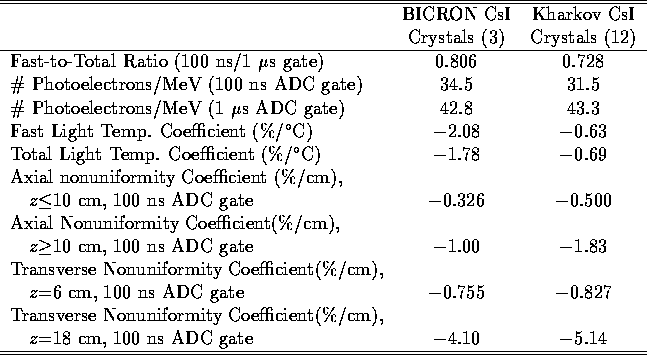
Table 0.2: Average scintillation properties of half-hexagonal and trapezial
PIBETA CsI calorimeter shapes HEX--D1/2s and VETO--1/2s (15 crystals).
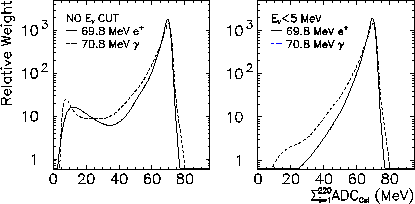
Figure 0.1: The predicted PIBETA calorimeter spectra of monoenergetic 69.8 MeV positrons and
70.8 MeV photons. The 220 ADC values above the 1 MeV TDC threshold were summed.
The GEANT simulation assumed the different numbers of photoelectrons/MeV and
linear axial light collection nonuniformities extracted from the tomography analysis.

Figure 0.2: The predicted PIBETA calorimeter spectra of monoenergetic 69.8 MeV positrons and
70.8 MeV photons. ADC values for the CsI crystal with the maximum ADC value together with
ADC readings of its nearest neighbors were summed.
The GEANT simulation assumed the different numbers of photoelectrons/MeV and
linear axial light collection nonuniformities measured in the tomography apparatus.
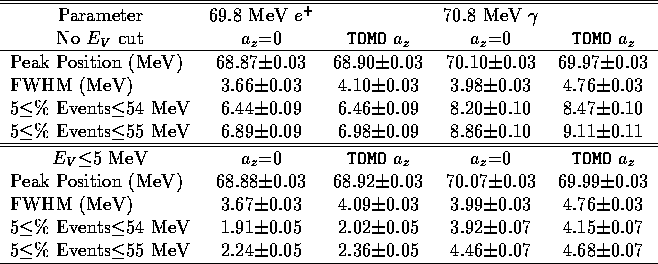
Table 0.3: The predicted energy resolutions and tail contributions for
69.8 MeV  , 70.8 MeV
, 70.8 MeV  's events in the full PIBETA calorimeter.
The light output in photoelectrons/MeV and the linear axial light
collection nonuniformities measured for individual CsI crystals
were used in the GEANT simulation. The values for the perfect
optically homogeneous crystals were also shown.
's events in the full PIBETA calorimeter.
The light output in photoelectrons/MeV and the linear axial light
collection nonuniformities measured for individual CsI crystals
were used in the GEANT simulation. The values for the perfect
optically homogeneous crystals were also shown.
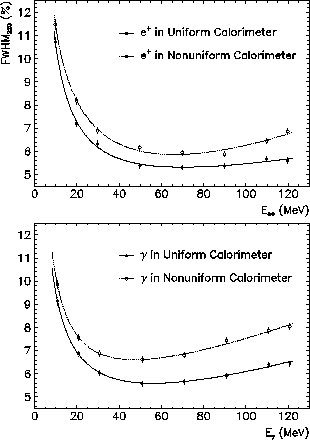
Figure 0.3: The predicted fractional energy resolution  of
the PIBETA calorimeter for positrons and photons in the energy range
10--120 MeV. The GEANT-deduced FWHM for the sum of 220 CsI ADCs is
shown both for the ideal homogeneous detector as well as for the nonuniform
calorimeter.
of
the PIBETA calorimeter for positrons and photons in the energy range
10--120 MeV. The GEANT-deduced FWHM for the sum of 220 CsI ADCs is
shown both for the ideal homogeneous detector as well as for the nonuniform
calorimeter.
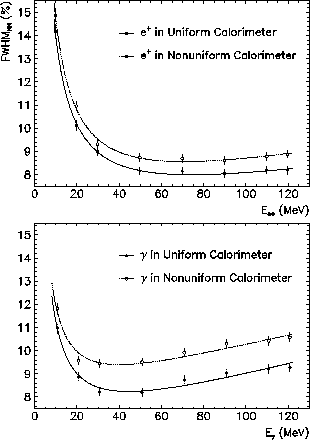
Figure 0.4: The GEANT-deduced  for the sum of nearest-neighbor CsI ADCs is
shown both for the ideal homogeneous detector as well as for the nonuniform
calorimeter.
for the sum of nearest-neighbor CsI ADCs is
shown both for the ideal homogeneous detector as well as for the nonuniform
calorimeter.
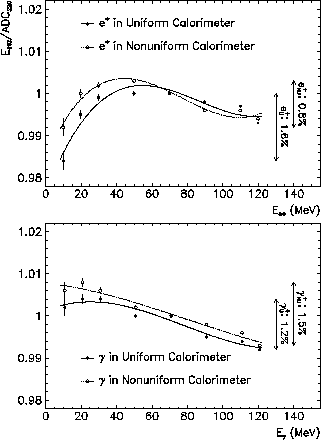
Figure 0.5: The nonlinearity of the PIBETA calorimeter energy response for positrons and
photons in the energy range 10--120 MeV. The ratio of the incident particle energy
to the detected ADC peak position is calculated in GEANT simulation. The
results for the ideal homogeneous detector and the nonuniform
calorimeter are shown separately.
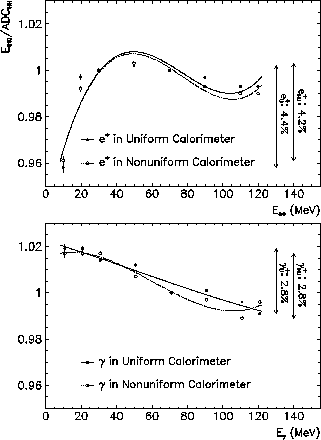
Figure 0.6: The nonlinearity of the PIBETA calorimeter energy response for positrons and
photons in the energy range 10--120 MeV. The ratio of the incident particle energy
to the detected peak position of summed nearest-neighbor ADCs is calculated in
GEANT simulation.



Next: About this document
Emil Frlez
Wed Jan 8 02:49:17 MET 1997


 decay rate are reported. Seventy-seven
individual crystals were scanned with a
decay rate are reported. Seventy-seven
individual crystals were scanned with a  Cs radioactive source,
probed with monoenergetic muon, pion and proton beams and examined in the
multiwire drift chamber system specially designed for three-dimensional
cosmic muon tomography. Critical elements of the apparatus and
reconstruction algorithms enabling measurement of spatial detector optical
nonuniformities are described. Results are compared with a Monte Carlo
simulation of an ideal detector light response. The deduced optical
nonuniformity contributions to the FWHM energy resolution of the PIBETA CsI
calorimeter for the
Cs radioactive source,
probed with monoenergetic muon, pion and proton beams and examined in the
multiwire drift chamber system specially designed for three-dimensional
cosmic muon tomography. Critical elements of the apparatus and
reconstruction algorithms enabling measurement of spatial detector optical
nonuniformities are described. Results are compared with a Monte Carlo
simulation of an ideal detector light response. The deduced optical
nonuniformity contributions to the FWHM energy resolution of the PIBETA CsI
calorimeter for the 

 69.8 MeV positrons and the
monoenergetic 70.8 MeV photons were 2.7% and 3.7%, respectively. The
upper limit of optical nonuniformity correction to the 69.8 MeV positron
low-energy tail between 5 and 55 MeV was +0.2%, as opposed to the
+0.3% tail contribution for the equivalent-energy photon. Imposing the 5
MeV calorimeter veto cut to discriminate the electromagnetic losses
GEANT-evaluated positron and photon lineshape tail fractions were found to
be 2.36
69.8 MeV positrons and the
monoenergetic 70.8 MeV photons were 2.7% and 3.7%, respectively. The
upper limit of optical nonuniformity correction to the 69.8 MeV positron
low-energy tail between 5 and 55 MeV was +0.2%, as opposed to the
+0.3% tail contribution for the equivalent-energy photon. Imposing the 5
MeV calorimeter veto cut to discriminate the electromagnetic losses
GEANT-evaluated positron and photon lineshape tail fractions were found to
be 2.36 0.05(stat)
0.05(stat) 0.20(sys)% and
4.68
0.20(sys)% and
4.68 0.07(stat)
0.07(stat) 0.20(sys)%, respectively.
0.20(sys)%, respectively.




 C. All other parameters were measured at the average room
temperature of 22
C. All other parameters were measured at the average room
temperature of 22 C.
C.



 , 70.8 MeV
, 70.8 MeV  's events in the full PIBETA calorimeter.
The light output in photoelectrons/MeV and the linear axial light
collection nonuniformities measured for individual CsI crystals
were used in the GEANT simulation. The values for the perfect
optically homogeneous crystals were also shown.
's events in the full PIBETA calorimeter.
The light output in photoelectrons/MeV and the linear axial light
collection nonuniformities measured for individual CsI crystals
were used in the GEANT simulation. The values for the perfect
optically homogeneous crystals were also shown.
 of
the PIBETA calorimeter for positrons and photons in the energy range
10--120 MeV. The GEANT-deduced FWHM for the sum of 220 CsI ADCs is
shown both for the ideal homogeneous detector as well as for the nonuniform
calorimeter.
of
the PIBETA calorimeter for positrons and photons in the energy range
10--120 MeV. The GEANT-deduced FWHM for the sum of 220 CsI ADCs is
shown both for the ideal homogeneous detector as well as for the nonuniform
calorimeter.

 for the sum of nearest-neighbor CsI ADCs is
shown both for the ideal homogeneous detector as well as for the nonuniform
calorimeter.
for the sum of nearest-neighbor CsI ADCs is
shown both for the ideal homogeneous detector as well as for the nonuniform
calorimeter.

